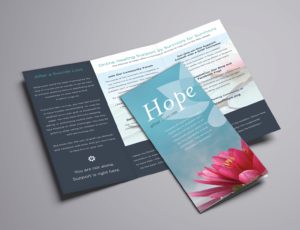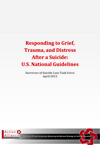
Educate Others
According to the U.S. Centers for Disease Control and Prevention (CDC), suicide rates have increased 35% since 1999. When suicides increase, so do the number of loss survivors who need support. Most who have experienced suicide loss say they never knew such pain existed – yet society is largely unaware of the of the degree to which survivors are impacted.
Consider these facts:
- Every 40 seconds, someone dies by suicide, leaving 6-8 loved ones grieving devastating loss.
- Approximately 45 million people have been greatly distressed by suicide, in the U.S. alone1. Many grapple with horrific, stigmatized loss, debilitating emotions, and complex personal challenges.
- Adult loss survivors are nearly 10 times more likely to consider suicide themselves in the initial months following loss2.
- Suicide loss survivors are 64% more likely to attempt suicide, and 80% more likely to quit their jobs or drop out of school – compared to those who have suffered sudden loss to a natural cause3.
- Suicide “postvention” is prevention.
- Suicide exposures and bereavement among American adults: Evidence from the 2016 General Social Survey. William Feigelman, Julie Cerel, John L. McIntosh, David Brent, Nina Gutin (Journal of Affective Disorders, Feb, 2018)
- Complicated grief and suicidal ideation in adult survivors of suicide. Mitchell AM, Kim Y, Prigerson HG, Mortimer MK Suicide Life Threat Behav. 2005 Oct; 35(5):498-506.
- British Medical Journal. (Jan. 2016). “Bereavement by suicide as a risk factor for suicide attempt: a cross-sectional national UK-wide study of 3,432 young bereaved adults.”
It’s time to focus on suicide loss survivors. You can help us educate others.
Learn what survivors need after suicide.
Survivors are often the forgotten victims. They suffer posttraumatic stress and are at high risk for taking their own lives – but often have a hard time finding help. Watch this 3-minute video from Frontline Medical News featuring Alliance of Hope founder, Ronnie Susan Walker.
Share our “Hope after Suicide” brochure.
Our trifold brochure provides an overview of the services offered by the Alliance of Hope, and lets new survivors know they are not alone. Share with local first responders, support group leaders, funeral directors, schools, and other suicide prevention stakeholders. Please click here to complete our brochure request form.
Understand why “suicide postvention” is suicide prevention.
Watch and share this 5-minute video.
Read the US National Guidelines for Suicide Aftercare.
Review the Executive Summary of the U.S. National Guidelines: “Responding to Grief, Trauma, and Distress after a Suicide” by the National Action Alliance for Suicide Prevention, Survivors of Suicide Loss Task Force.
Share the Alliance of Hope’s Resources with others.
Share our website, online community forum, and blog with loss survivors and those who want to help.
These resources are a great start to educating ourselves and others about suicide loss.
Contact us if you have questions or are seeking additional information.



